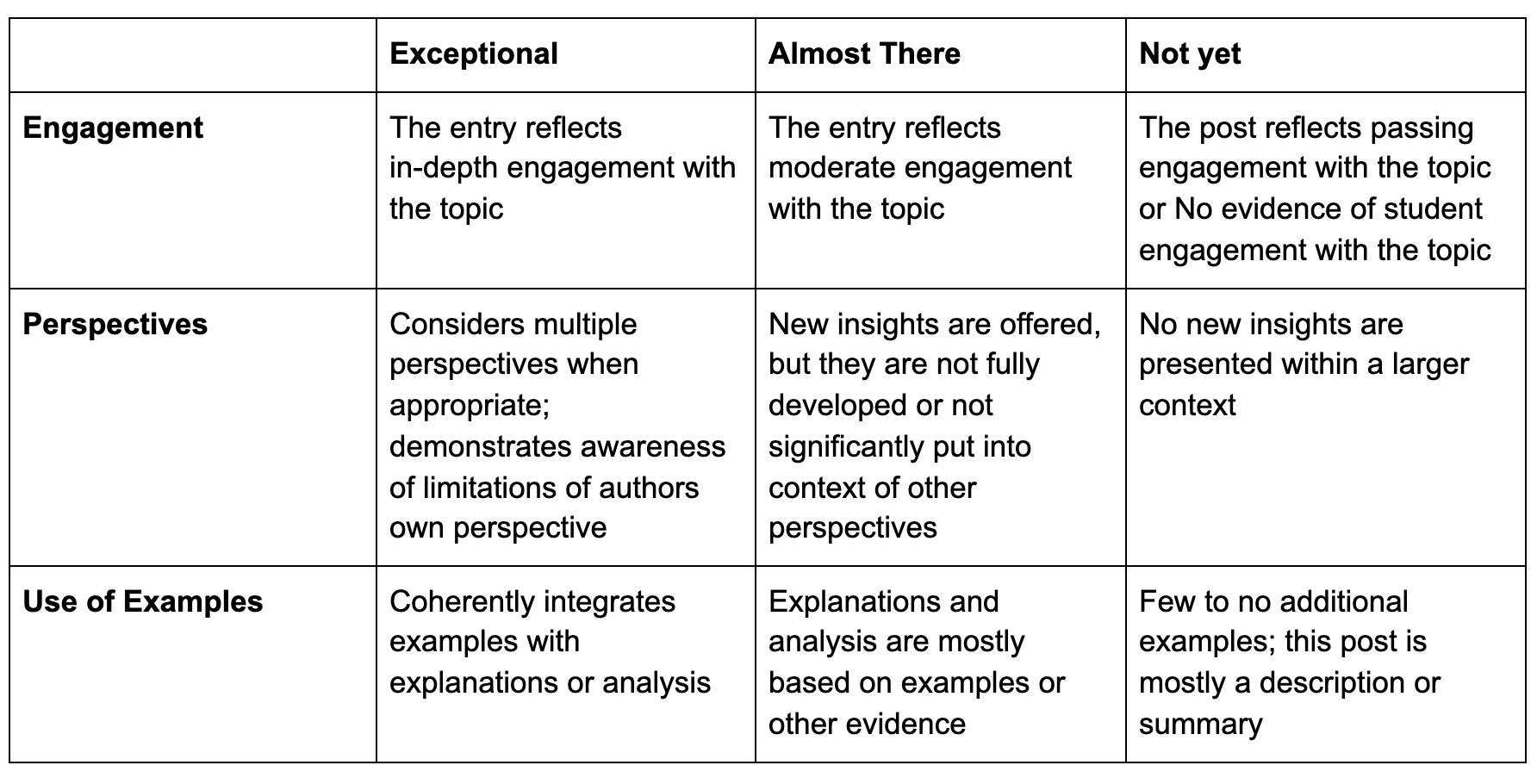

Regardless of whether your course is online or face to face, you will need to provide feedback to your students on their strengths and areas for growth. Rubrics are one way to simplify the process of providing feedback and consistent grades to your students.
Rubrics are “scoring sheets” for learning tasks. There are multiple flavors of rubrics, but they all articulate two key variables for scoring how successful the learner has been in completing a specific task: the criteria for evaluation and the levels of performance. While you may have used rubrics in your face-to-face class, rubrics become essential when teaching online. Rubrics will not only save you time (a lot of time) when grading assignments, but they also help clarify expectations about how you are assessing students and why they received a particular grade. It also makes grading feel more objective to students (“I see what I did wrong here”), rather than subjective (“The teacher doesn’t like me and that’s why I got this grade.”).
When designing a rubric, ideally, the criteria for evaluation need to be aligned with the learning objectives [link to learning objectives] of the task. For example, if an instructor asks their learners to create an annotated bibliography for a research assignment, we can imagine that the instructor wants to give the students practice with identifying valid sources on their research topic, citing sources correctly (using the appropriate format), and summarizing sources appropriately. The criteria for evaluation in a rubric for that task might be
The levels of performance don’t necessarily have a scale they must align with. Some rubric types might use a typical letter grading scale for their levels – these rubrics often include language like “An A-level response will….” Other rubric types have very few levels of performance; sometimes they are as simple as a binary scale – complete or incomplete (a checklist is an example of this kind of rubric). How an instructor thinks about the levels of performance in a rubric is going to depend on a number of factors, including their own personal preferences and approaches to evaluating student work, and on how the task is being used in the learning experience. If a task is not going to contribute to the final grade for the course, it might not be necessary (or make sense) to provide many fine-grained levels of performance. On the other hand, an assignment that is designed to provide detailed information to the instructor as to how proficient each student is at a set of skills might need many, highly specific levels of performance. At the end of this module, we provide examples of different types of rubrics and structures for levels of performance.
What teaching goals can rubrics help meet?
In an online course, clear communication from the instructor about their expectations is critical for student success and success of the course. Effective feedback, where it is clear to the learner what they have already mastered and where there are gaps in the learners knowledge or skills, is necessary for deep learning. Rubrics help an instructor clearly explain their expectations to the class as a whole while also making it easier to give individual students specific feedback on their learning.
Although one of the practical advantages to using rubrics is to make grading of submitted assignments more efficient, they can be used for many, not mutually exclusive, purposes:
Different styles of rubrics are better fits for different task-types and for fulfilling the different teaching aims of a rubric . Here we focus on four different styles with varying levels of complexity: single point rubric, Specific task rubrics, general rubrics, holistic rubrics and analytical rubrics (Arter, J. A., & Chappuis, J., 2007).
Sometimes, simple is easiest. A single point rubric can tell students whether they met the expectations of the criteria or not. We’d generally recommend not using too many criteria with single point rubrics, they aren’t meant for complicated evaluation. They are great for short assignments like discussion posts.
Example task: Write a 250 discussion post reflecting on the purpose of this week’s readings. (20 points)
Example rubric:

This style of rubric is useful for articulating the knowledge and skill objectives (and their respective levels) of a specific assignment.
Example task:
Design and build a trebuchet that is adjustable to launch a
Example rubric:

This style of rubric enables a single, overall assessment/evaluation of a learner’s performance on a task
Example task:
Write a historical research paper discussing ….
Example rubric:

This style of rubric can be used for multiple, similar assignments to show growth (achieved and opportunities) over time.
Example task:
Write a blog post appropriate for a specific audience exploring the themes of the reading for this week.
Example rubric:

This style of rubric is well suited to breaking apart a complex task into component skills and allows for evaluation of those components. It can also help determine the grade for the whole assignment based on performance on the component skills. This style of rubric can look similar to a general rubric but includes detailed grading information.
Example task:
Write a blog post appropriate for a specific audience exploring the themes of the reading for this week.
Example rubric:

You can approach designing a rubric from multiple angles. Here we outline just one possible procedure to get started. This approach assumes the learning task is graded, but it can be generalized for other structures for levels of performance.
Arter, J. A., & Chappuis, J. (2007). Creating & recognizing quality rubrics. Upper Saddle River, NJ: Pearson Education.
Gilbert, P. K., & Dabbagh, N. (2004). How to structure online discussions for meaningful discourse: a case study. British Journal of Educational Technology, 36(1), 5–18. doi: 10.1111/j.1467-8535.2005.00434.x
Wyss, V. L., Freedman, D., & Siebert, C. J. (2014). The Development of a Discussion Rubric for Online Courses: Standardizing Expectations of Graduate Students in Online Scholarly Discussions. TechTrends, 58(2), 99–107. doi: 10.1007/s11528-014-0741-x

COVID-19 caught everyone off guard in 2020. Suddenly, all classes had to be held online and instructors and students had to react quickly with minimal help.…

Echoes of “Can we have a study guide?” still reverberate through the virtual classrooms, even as summer takes hold and the allure of relaxation sets in.…
Subscribe For UpdatesKeep up with the latest developments related to designing and facilitating online courses.